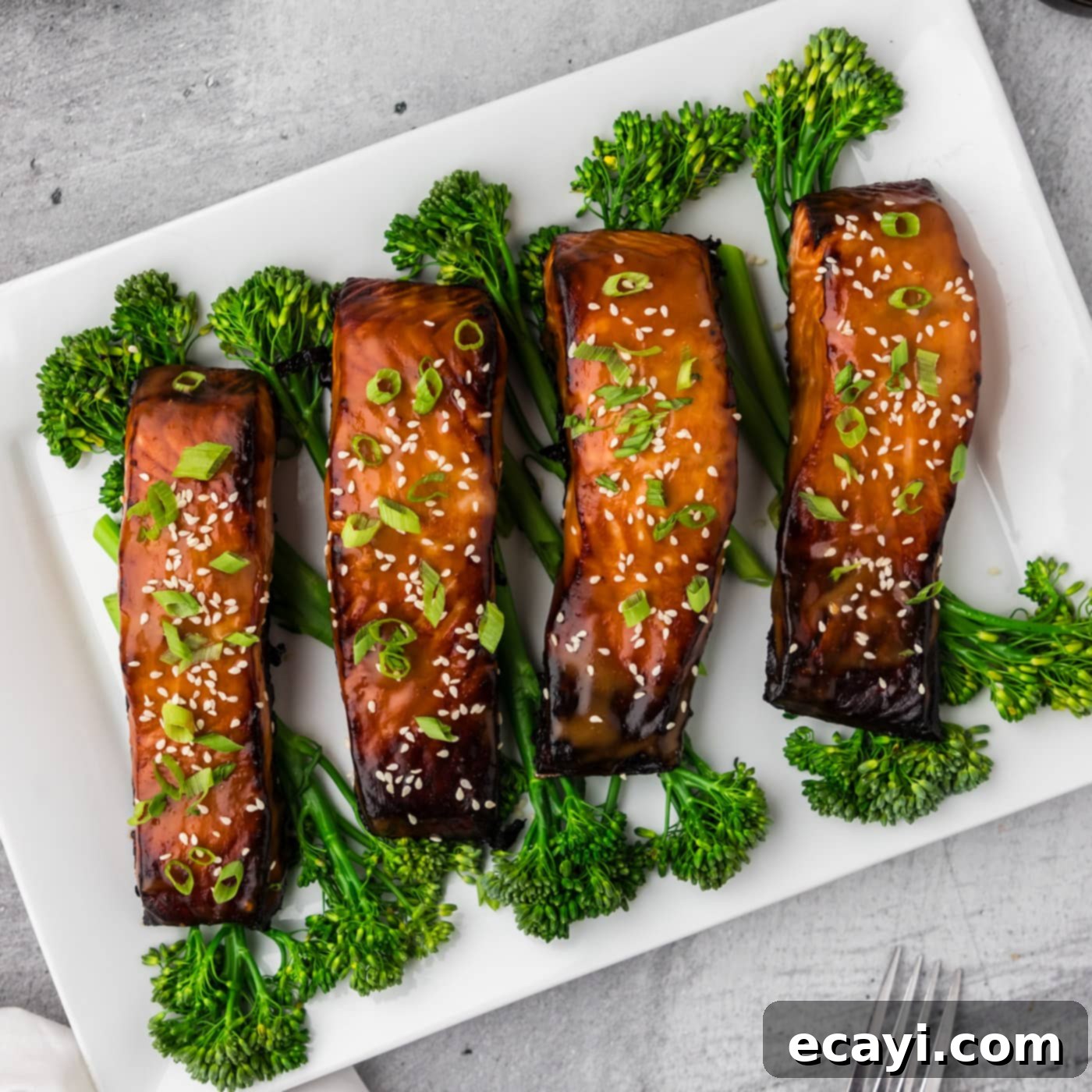Irresistible Baked Miso Salmon: Your Go-To Recipe for Flavorful, Healthy Meals
Prepare to delight your taste buds with this incredible baked miso salmon recipe. Each flaky, tender salmon fillet is infused with a unique, deeply savory yet subtly sweet marinade, creating a culinary experience that’s both gourmet and incredibly easy to achieve at home. This dish combines the rich, umami depth of miso with the delicate texture of salmon, all brought together in a harmonious glaze that caramelizes beautifully as it bakes. It’s a perfect weeknight meal or an impressive dish for entertaining, promising a burst of delicious flavor in every bite and making healthy eating an absolute pleasure.
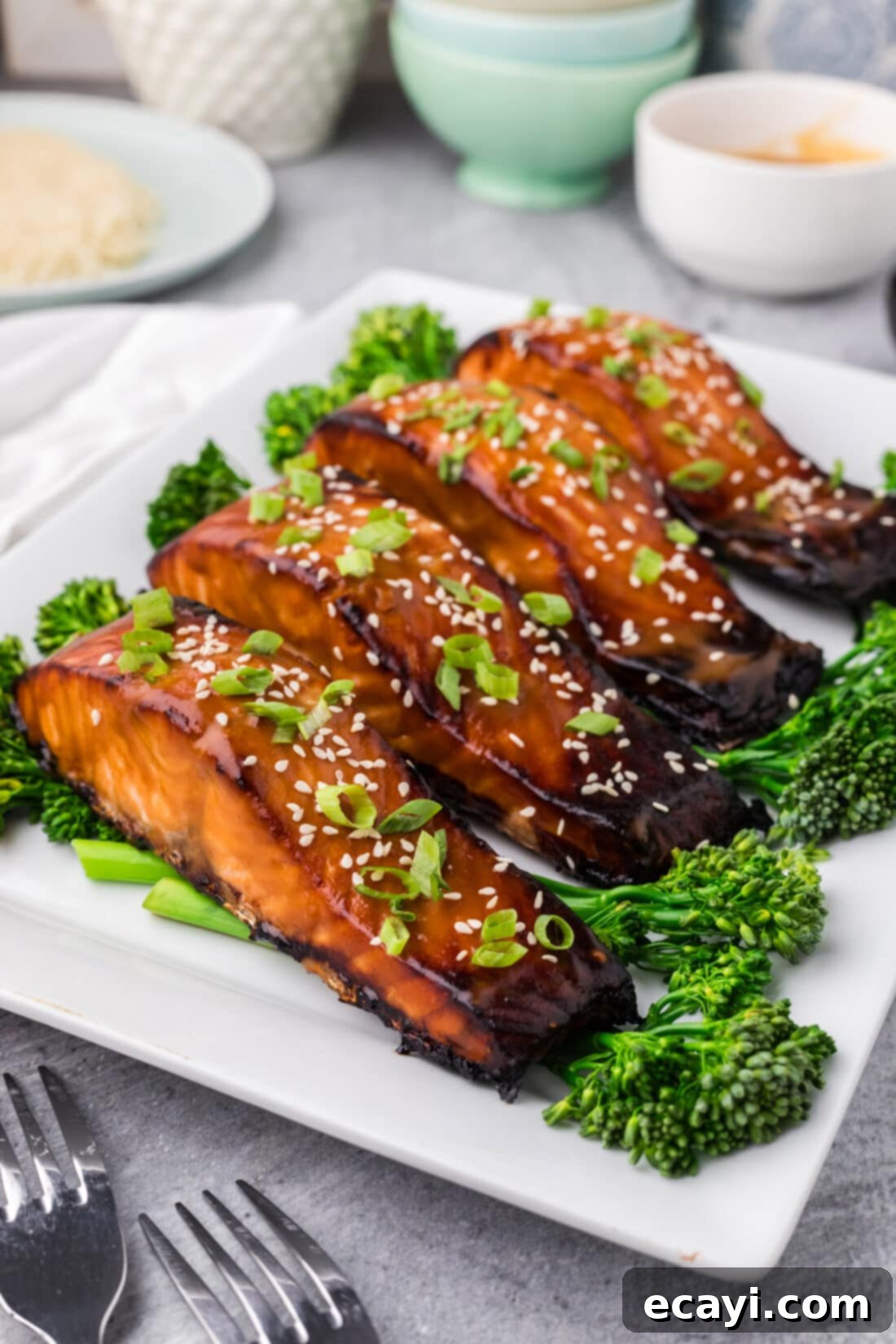
Why This Miso Salmon Recipe is a Must-Try
This baked miso salmon recipe stands out for several compelling reasons, making it a stellar addition to any home cook’s repertoire. It all begins with our expertly crafted sweet and savory marinade, a vibrant concoction of white miso paste, high-quality soy sauce, aromatic sesame oil, a touch of sake, and bright rice vinegar. This carefully balanced blend of ingredients doesn’t just flavor the salmon; it deeply infuses each fillet, creating an unparalleled depth of flavor that is both complex and incredibly satisfying. The umami-rich miso provides a foundational savoriness, while the other components add layers of sweetness, tang, and nutty warmth.
The true genius of this recipe lies in its innovative two-in-one approach. After the salmon has absorbed the magnificent flavors of the marinade, we ingeniously transform the remaining liquid into a thick, glossy, and caramelized glaze. This rich glaze is then generously brushed over the succulent, partially baked fillets, adding an extra layer of umami, a hint of sweetness, and a beautiful, enticing sheen. As it bakes further, the glaze caramelizes to perfection, creating a slightly crisp exterior that perfectly complements the delicate, flaky interior of the salmon. This dual use of the marinade ensures maximum flavor infusion and minimal waste, making it an efficient, economical, and undeniably delicious cooking method.
Salmon, renowned for its versatility and relatively neutral flavor profile, serves as the ideal canvas for the bold and complex notes of miso. Its rich, buttery texture holds up beautifully to the marinating process, absorbing the intricate flavors without being overwhelmed. This adaptability opens up a world of options when it comes to salmon marinades, seasonings, and different flavor profiles, but miso undeniably brings out some of its best qualities. Whether you’re a seasoned chef or a beginner in the kitchen, this recipe simplifies the art of cooking fish, consistently delivering moist, flavorful results. Beyond its exquisite taste, salmon is a powerhouse of nutrition, packed with omega-3 fatty acids, making this dish not only delicious but also incredibly healthy and beneficial for your well-being. It’s truly one of the best ways to enjoy salmon, elevating a simple fish dinner into a memorable dining experience that you’ll want to revisit again and again.
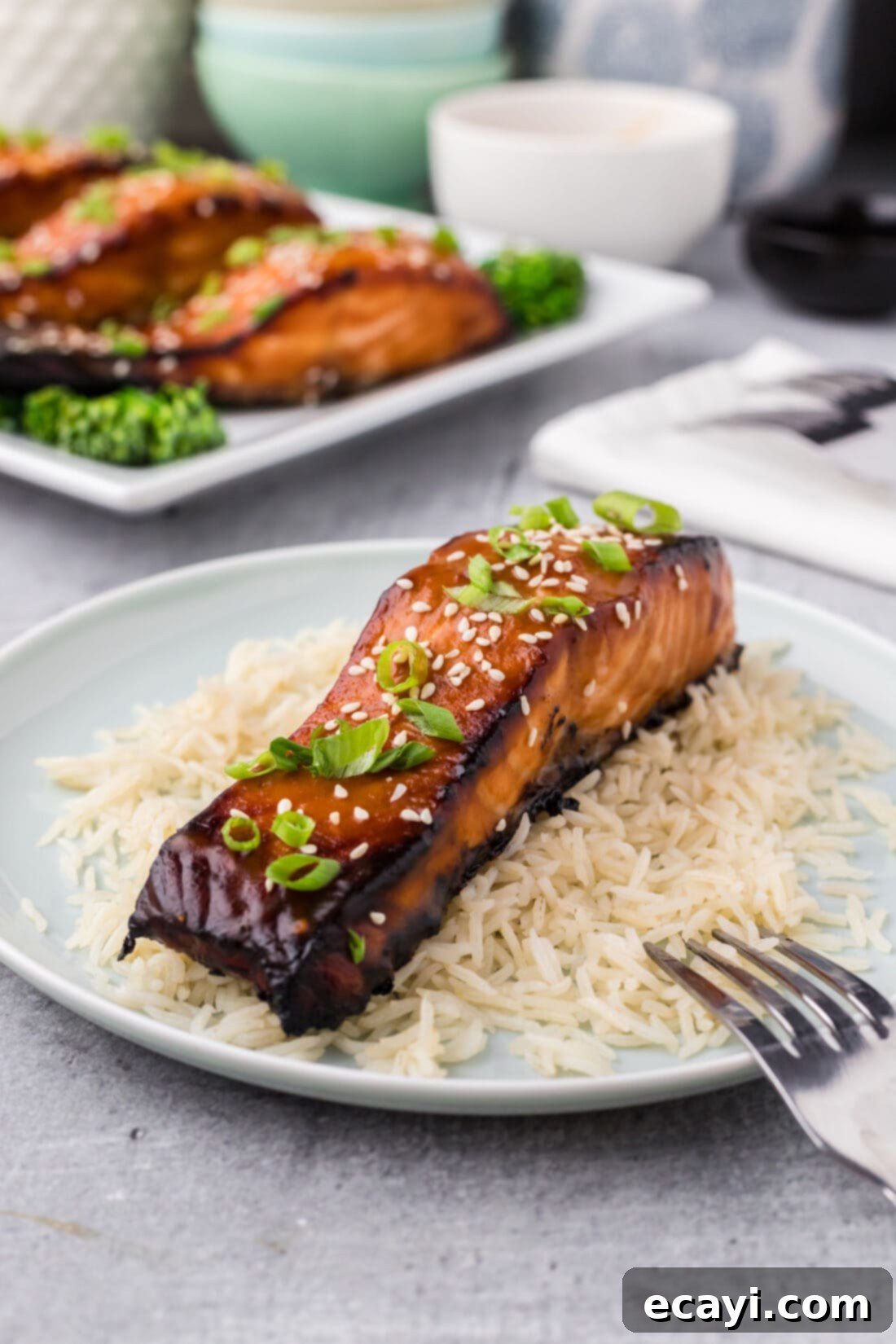
Key Ingredients for Miso Glazed Salmon
Crafting the perfect miso salmon requires a selection of fresh, high-quality ingredients that come together to create its signature, irresistible flavor profile. Each component plays a vital role in building the layered taste and texture of this beloved dish. You’ll find a detailed list of all measurements, required ingredients, and comprehensive instructions in the printable recipe card located conveniently at the conclusion of this article. For now, let’s explore the essential items you’ll need to gather to embark on this culinary adventure:
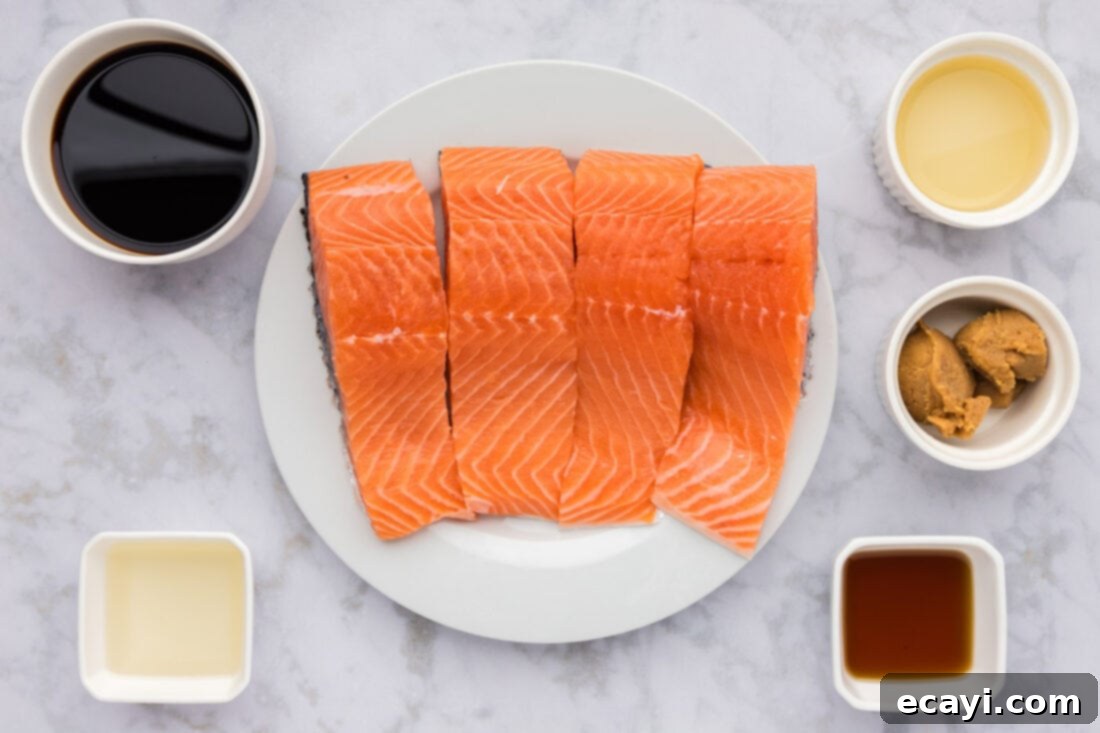
Ingredient Spotlight & Expert Substitution Tips
Understanding each ingredient’s unique contribution and knowing how to make smart, effective substitutions can not only elevate your cooking but also empower you to adapt recipes to your pantry and preferences. Here’s everything you need to know about the stars of our miso salmon dish:
Choosing the Best Salmon Fillets
SALMON – The cornerstone of this flavorful dish is, naturally, the salmon itself. When you’re selecting salmon from your local grocery store or fish market, choosing fresh, high-quality fillets is absolutely paramount to the success of your meal. Always look for fish that is firm to the touch, with a moist appearance and a vibrant, healthy pink or orange color. Be sure to steer clear of any fish displaying gray areas, brown spots, or visible blemishes, as these are clear indicators of age or improper handling. Center-cut salmon fillets are often the preferred choice because they offer a more uniform thickness, which is crucial for ensuring that all your portions cook evenly and perfectly. If you have a larger fillet, use a sharp chef’s knife to easily slice it into smaller, manageable portions. A key technique for baking fish is to always cook it with the skin side down. This serves multiple purposes: it acts as a natural barrier, protecting the delicate flesh from overcooking and helping to retain moisture, while simultaneously ensuring that the skin crisps up beautifully, adding a desirable textural contrast. If you were to place the fish skin-side up, it would tend to cook unevenly and begin to flake apart as you attempt to lift and serve it, making for a less appealing presentation.
Crafting the Perfect Miso Marinade
MARINADE – The marinade is truly where the magic happens for this dish, transforming simple salmon into an extraordinary meal by infusing it with its signature umami flavor and depth. The heart of this marinade is miso paste. Miso, a traditional Japanese seasoning, is produced by fermenting soybeans with salt and kōji (a fungus used in East Asian fermentation). It offers a rich spectrum of flavors. Light-colored miso pastes, like white (shiro) miso, are fermented for shorter periods, resulting in a milder, subtly sweeter, and saltier profile. This is the variety we’ve specifically opted for in our recipe, as it beautifully complements the delicate flavor of the salmon without overwhelming it, creating a harmonious blend. Darker miso pastes, such as red (aka) miso, are fermented for significantly longer durations, yielding a deeper, richer, and more intensely savory flavor. While any type of miso paste can technically work, if you choose a darker, more potent miso, we strongly recommend using low-sodium soy sauce to avoid an overly salty final dish. This thoughtful adjustment allows the complex, nuanced miso flavors to truly shine through without excessive salinity, ensuring a perfectly balanced taste.
- Soy Sauce: This essential ingredient contributes a deep salty, intensely savory umami base to the marinade. Opting for low-sodium soy sauce is a smart choice as it gives you greater control over the overall saltiness of the dish, especially when combined with the inherent saltiness of miso paste.
- Sesame Oil: Just a small amount of sesame oil adds a distinct nutty aroma and a rich, characteristic flavor that is instantly recognizable in many Asian-inspired dishes. It provides a wonderful aromatic depth to the marinade.
- Sake: More than just a Japanese rice wine for sipping, sake plays a vital role in marinades. It acts as a natural tenderizer for the salmon, while also enhancing the savory notes and contributing a subtle sweetness and a layer of complex aroma to the overall flavor profile.
- Rice Vinegar: This ingredient provides a crucial acidic component that expertly balances the richness of the salmon and the savory depth of the miso. It cuts through the intensity, adding a bright, tangy finish that prevents the glaze from being too heavy and keeps the flavors lively.
Step-by-Step Guide: Crafting Delicious Baked Miso Salmon
These detailed step-by-step photos and instructions are specifically provided to help you visualize and confidently execute each stage of making this delectable miso salmon recipe. For a convenient printable version, complete with precise measurements for all ingredients and full instructions, simply Jump to Recipe at the very bottom of this post.
- In a large mixing bowl, meticulously whisk together all the marinade ingredients until they are thoroughly combined and no lumps remain. This initial mix is crucial for integrating all the powerful flavors. For a truly silky-smooth consistency, essential for a flawless glaze, pour this entire mixture into an immersion blender (or a regular blender) and process until the marinade is completely smooth and emulsified. This ensures the miso is fully incorporated.
- Carefully place your fresh salmon fillets into a gallon-sized zip-top bag. Pour the smooth, intensely aromatic marinade over the salmon, ensuring each piece is fully coated on all sides. Seal the bag, pressing out as much air as possible, and gently massage the marinade into the fish to ensure even distribution. Place the sealed bag in the refrigerator and allow the salmon to marinate for a minimum of 2 hours, or ideally up to 4 hours. This marinating time is absolutely crucial for the flavors to deeply penetrate the fish, resulting in a significantly more flavorful and tender baked miso salmon.
- Approximately 20 minutes before you intend to bake the salmon, begin preheating your oven to a precise 425°F (220°C). As the oven heats up, prepare your baking sheet by lining a large one with parchment paper. This simple yet effective step is key to preventing the salmon from sticking and will make your post-meal cleanup incredibly easy.
- Once the marinating time is complete, carefully remove the salmon fillets from the zip-top bag. **Crucially, do not discard the remaining marinade** – this flavorful liquid will be transformed into our exquisite caramelized glaze! Place the salmon fillets, skin side down, onto the prepared baking sheet. Arranging them skin-side down is essential not only for achieving even cooking but also for ensuring the skin becomes delightfully crispy and the fillet remains firm and intact when serving.
- Transfer the baking sheet with the salmon to the preheated oven and bake for an initial period of 18-20 minutes. During this first baking phase, the salmon will begin to cook through, and its rich, savory aromas will start to fill your kitchen, building anticipation for the delicious meal to come.
- Meanwhile, turn your attention to creating the luscious, glossy glaze. Pour the reserved marinade into a medium saucepan and place it over medium-high heat. In a separate small bowl, whisk together the cornstarch and water to form a smooth, lump-free slurry. Once the marinade in the saucepan begins to warm and simmer gently, slowly add the cornstarch slurry, stirring continuously with a whisk or spoon. Cook, stirring occasionally to prevent sticking, until the mixture begins to thicken into a glossy, rich glaze. The cornstarch is vital here, helping it achieve that perfect syrupy consistency. Remove the thickened glaze from the heat once it reaches your desired consistency – it will thicken further as it cools slightly.
- After the initial baking time, carefully remove the pan with the salmon from the oven. Using a clean pastry brush, generously baste the partially cooked salmon fillets with the freshly thickened, aromatic miso glaze. Ensure an even and ample coating over each fillet. Return the baking sheet to the oven and continue to bake for an additional 8-10 minutes. This second baking stage is where the glaze truly shines, caramelizing beautifully, deepening its flavor, and creating an appealing golden-brown, slightly sticky crust on the salmon.
- Once the salmon is perfectly cooked through (check internal temperature if unsure) and the glaze is caramelized to perfection, remove the pan from the oven. For an extra layer of flavor and visual appeal, brush the fillets lightly with any remaining thickened glaze immediately after removing them. Garnish generously with vibrant, thinly sliced green onions and a sprinkle of toasted sesame seeds before serving. Enjoy your beautifully baked, incredibly tender, and intensely flavorful miso salmon!
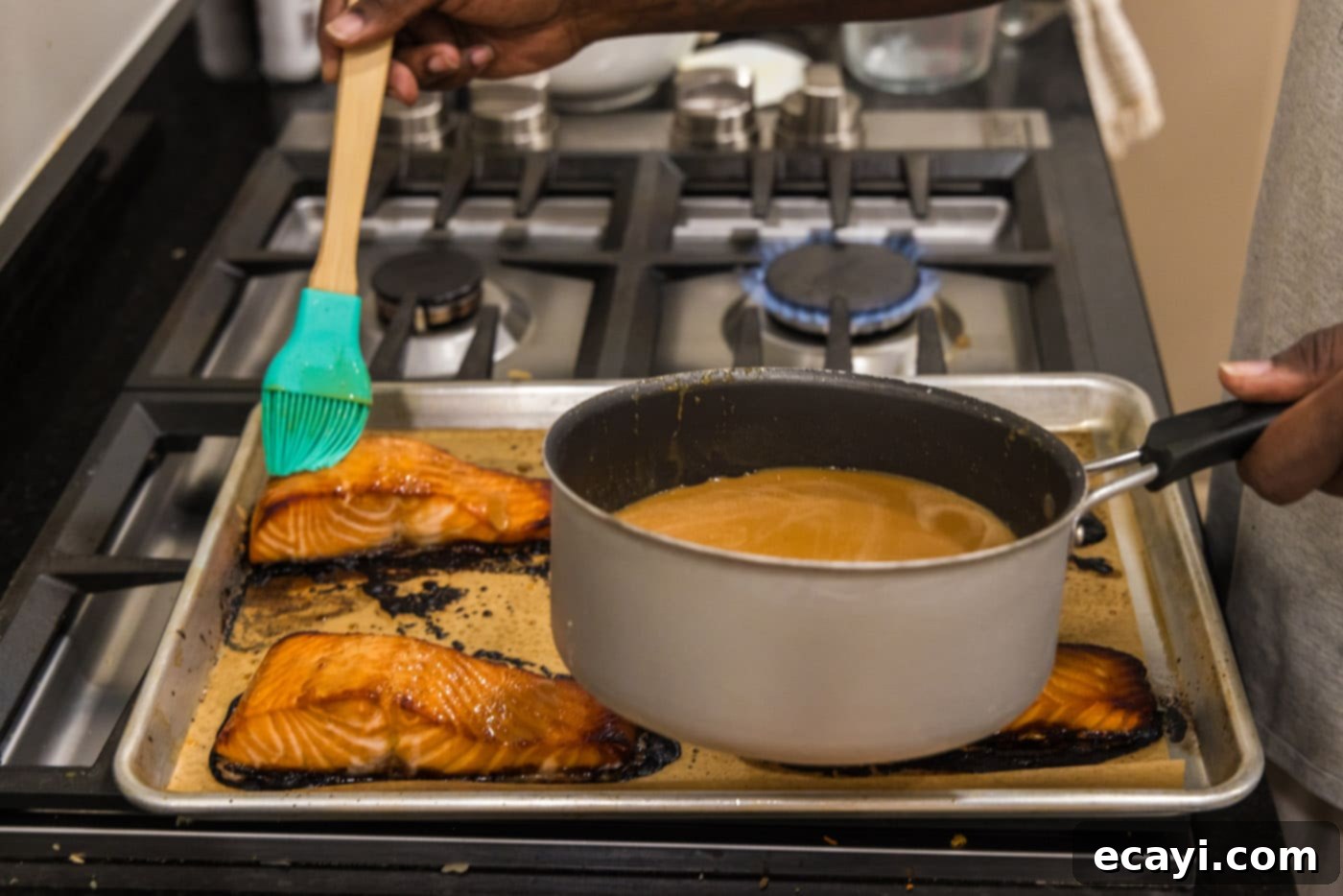
Frequently Asked Questions & Expert Tips for Perfect Miso Salmon
Achieving the perfect doneness for salmon is absolutely crucial for moist, flaky, and enjoyable fillets. Salmon, especially individual fillets, can quickly become dry, tough, and less enjoyable if overcooked. For the best results, we highly recommend using an instant-read thermometer to check the internal temperature at the thickest part of the fillet. Aim for an internal temperature of 135°F (57°C) for medium-rare to medium doneness, which will yield a very moist and tender texture. If you prefer your salmon cooked through, aim for 145°F (63°C). Remember that fish continues to cook slightly after it’s removed from the heat (this is known as carryover cooking), so pulling it out a few degrees early is often a good strategy to prevent overcooking. Keep in mind that larger or thicker fillets will naturally require a few extra minutes in the oven to reach the desired temperature compared to thinner cuts.
To ensure the delicious flavors and optimal texture of your baked miso salmon are preserved, it’s essential to store any leftovers promptly and correctly. Once the salmon has cooled to room temperature, place the fillets in an airtight container. This container should then be kept in the refrigerator, where the salmon will remain fresh and safe to eat for up to 3 days. When it’s time to reheat, we recommend using a low and slow method to prevent the fish from drying out. Reheat the salmon in a 275°F (135°C) oven for 10-15 minutes, or until it is just warmed through. Avoid using the microwave if possible, as it can often make the delicate salmon flesh rubbery and compromise its texture.
Absolutely, you can certainly use frozen salmon fillets for this recipe! However, it is critically important to fully thaw them before you begin the marinating process. For the best results and to ensure even marination and cooking, the ideal method is to transfer your frozen salmon from the freezer to the refrigerator the night before. This allows it to thaw slowly and safely overnight. If you find yourself short on time, you can also thaw the salmon by placing it in its sealed packaging (or a zip-top bag) under cold running water for about 30-60 minutes, depending on thickness, changing the water every 15 minutes.
While this recipe specifically outlines instructions for baking, miso salmon is incredibly versatile and also cooks beautifully on the grill or in a pan! For grilling, preheat your grill to medium heat. Cook the salmon skin-side down first for about 5-7 minutes until the skin is crispy and releases easily, then flip and cook for another 3-5 minutes, or until it reaches your desired internal temperature. For pan-frying, use a non-stick skillet with a tablespoon of oil over medium-high heat. Cook skin-side down for most of the cooking time (about 6-8 minutes), allowing the skin to crisp up and the flesh to cook through, then briefly flip for 1-2 minutes to finish. Always rely on an instant-read thermometer for accuracy, as cooking times will vary with fillet thickness and heat intensity.
Using an immersion blender (or a regular countertop blender) for your miso marinade offers significant benefits, primarily ensuring a perfectly smooth and homogenous mixture. This is especially advantageous with miso paste, which can sometimes be quite thick or lumpy. A thoroughly blended, smooth marinade coats the salmon more evenly and efficiently, allowing for maximum flavor penetration into every part of the fillet. Furthermore, it helps to fully emulsify all the liquid components – the oils, vinegars, and sake – with the miso, preventing any separation of ingredients. This results in a more consistent and beautiful glaze later on, contributing to both the exquisite taste and appealing presentation of your final dish. The smooth texture also prevents any burnt bits from unevenly mixed ingredients.
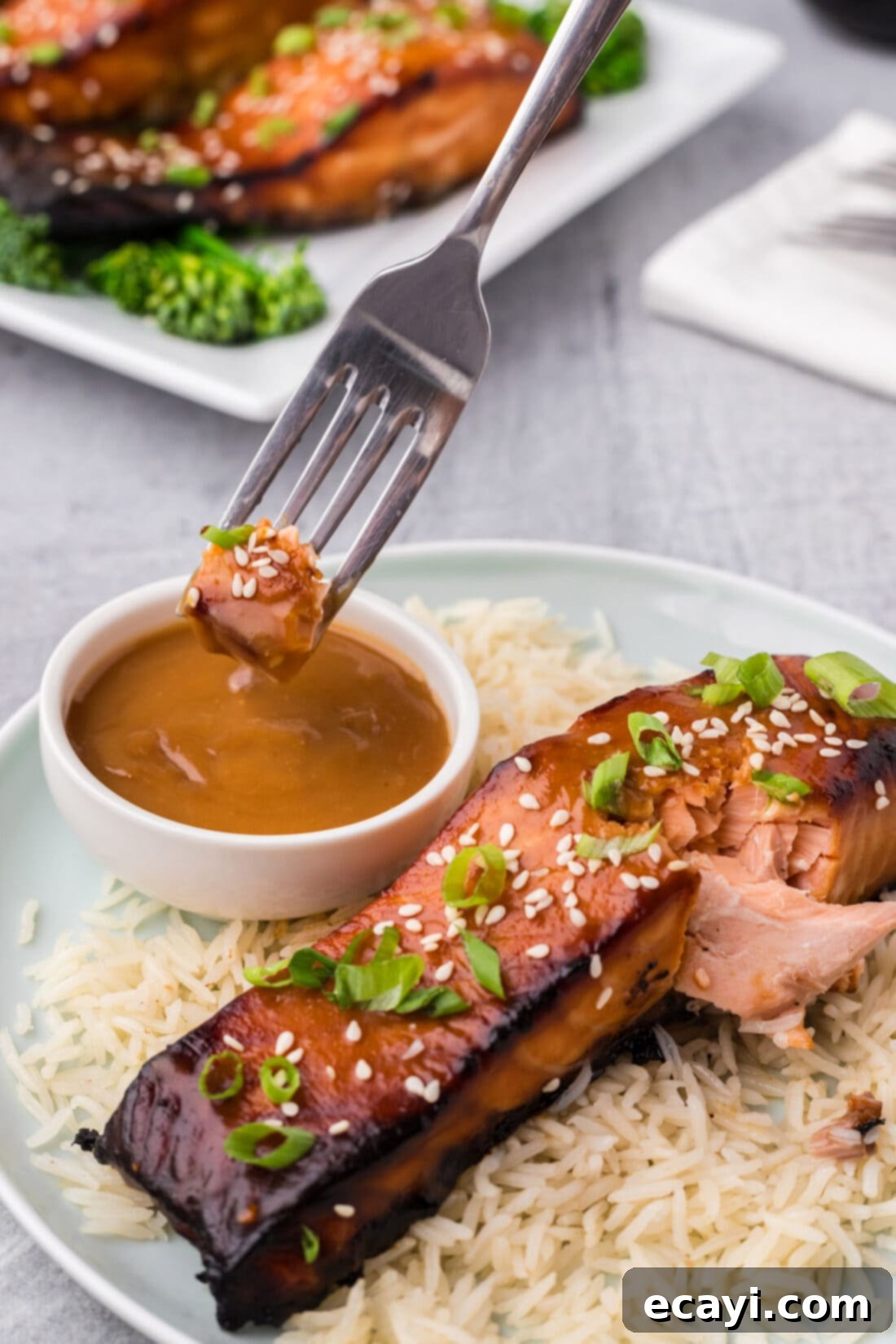
Delicious Serving Suggestions for Miso Salmon
Miso salmon is a wonderfully versatile dish that pairs harmoniously with a wide array of sides, allowing you to create a well-rounded, nutritious, and incredibly satisfying meal. The rich, umami-forward flavors of the salmon are beautifully complemented by simple, fresh accompaniments. Serve your perfectly baked miso salmon proudly over a fluffy bed of perfectly cooked white rice, such as aromatic jasmine or traditional sushi rice, to soak up all the delicious glaze. For those seeking a healthier or more fibrous alternative, nutty brown rice or protein-rich quinoa are excellent choices. To add a vibrant and nutritious touch, consider serving it alongside steamed edamame, lightly sautéed bok choy, crisp-tender asparagus spears, or perfectly steamed broccoli florets. The freshness and slight crunch of these vegetables provide a lovely contrast to the savory fish. To elevate both the presentation and add an extra layer of flavor and delicate crunch, don’t forget the optional garnishes: a generous sprinkle of toasted sesame seeds offers a delightful texture and nutty aroma, while thinly sliced green onions provide a burst of fresh, mild oniony zest and a pop of color. A small side of pickled ginger can also offer a refreshing palate cleanser, cutting through the richness beautifully. Enjoy this delightful and memorable meal!
Explore More Delicious Salmon Recipes
If you’ve fallen in love with the versatility, health benefits, and exquisite flavor of salmon, you’re in for a treat! There’s a whole world of exciting and diverse recipes waiting to be discovered beyond this fantastic miso salmon. Salmon adapts beautifully to various cooking methods and flavor profiles, making it a favorite for many home cooks. Here are some other fantastic ways to prepare this healthy and delicious fish, each offering a unique culinary experience:
- Honey Glazed Salmon: A wonderfully sweet and sticky delight, perfect for those who adore a touch of golden sweetness to complement their savory fish.
- Zesty Cajun Salmon: Bring a vibrant kick of spice and robust flavors inspired by the Louisiana bayou right to your dinner table for an exciting twist.
- Classic Teriyaki Salmon: A timeless and universally loved favorite, featuring a luscious, glossy, and perfectly balanced sweet and savory teriyaki glaze.
- Elegant Stuffed Salmon: Impress your guests and elevate your meal with salmon fillets generously filled with a delectable mix of flavorful ingredients, making for a truly special dish.
- Bold Spicy Salmon: For those who crave an extra punch of heat, this recipe delivers a fiery, unforgettable taste experience that will awaken your taste buds.
I absolutely adore spending time in the kitchen, experimenting with new flavors, creating delicious dishes, and sharing my culinary journey and experience with all of you! I understand that remembering to come back and check for new recipes each day can be tough amidst a busy schedule, which is precisely why I offer a convenient newsletter. This free service delivers a fresh recipe directly to your inbox every single time a new one is posted. Simply subscribe today and start receiving your free daily recipes, ensuring you never miss a delicious update or a moment of culinary inspiration!
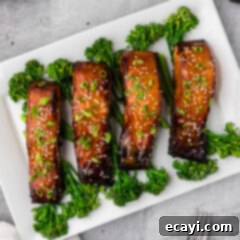
Baked Miso Salmon
IMPORTANT – There are often Frequently Asked Questions within the blog post that you may find helpful. Simply scroll back up to read them!
Print It
Pin It
Rate It
Save ItSaved!
Ingredients
- 2 pounds center cut salmon cut into 4 fillets
- 1 Tablespoon cornstarch
- ¼ cup water
Marinade
- 3 ½ Tablespoons white miso paste
- ½ cup soy sauce
- 2 ½ Tablespoons sesame oil
- ¼ cup sake
- 2 ½ Tablespoons rice vinegar
Optional Garnish
- sliced green onion tops
- sesame seeds
Things You’ll Need
-
immersion blender
-
Baking sheet
-
Saucepan
-
Pastry brush
Before You Begin
- When choosing salmon from the grocery store, steer clear of any fish with gray areas or blemishes. Filets should be firm and have a vibrant pink color. Center-cut salmon provides uniform thickness between your filets. Use a sharp chef’s knife to slice into smaller filets.
- You can use frozen salmon filets, but be sure to thaw them before beginning.
- The type of miso paste you use is up to your preference. Light-colored miso pastes have more of a salty-sweet profile, while darker pastes are deeply savory due to being fermented longer. We opted for white miso paste in ours but any kind will work. I would suggest using low-sodium soy sauce if you choose to use a dark miso.
- Always cook fish with the skin side down. If you place the fish skin side up, it will cook and begin to flake, making it fall apart as you lift it.
Instructions
-
In a large mixing bowl, whisk together all marinade ingredients. Pour mixture into an immersion blender and blend until smooth.
-
Place salmon filets into gallon zip top bag and pour the marinade in. Close the bag and marinate in the fridge for 2 hours.
-
Preheat oven to 425 F. Line a large baking sheet with parchment paper.
-
Remove salmon from marinade, do not discard marinade. Place salmon filets skin side down, onto prepared baking sheet.
-
Bake in oven for 18-20 minutes.
-
Meanwhile, place marinade in a medium saucepan over medium high heat. Make a slurry from the cornstarch and water and add it to the saucepan. Cook, stirring occasionally, until mixture begins to thicken. Remove from heat.
-
Remove pan from oven and brush the salmon filets with the thickened marinade. Return to the oven and bake an additional 8-10 minutes.
-
Remove from oven and brush lightly with thickened marinade and garnish with sesame seeds and sliced green onions.
Expert Tips & FAQs
- Cooking salmon to the perfect temperature is really important for flakey, moist fillets. Salmon (especially individual fillets) become dry when overcooked. Use an instant-read thermometer to check for doneness when it reaches 135F. Keep in mind the larger your fillets, the more time it may need in the oven.
- Store any leftovers in an air-tight container kept in the refrigerator for up to 3 days. Reheat in a 275F oven for 10-15 minutes or until warmed through.
Nutrition
The recipes on this blog are tested with a conventional gas oven and gas stovetop. It’s important to note that some ovens, especially as they age, can cook and bake inconsistently. Using an inexpensive oven thermometer can assure you that your oven is truly heating to the proper temperature. If you use a toaster oven or countertop oven, please keep in mind that they may not distribute heat the same as a conventional full sized oven and you may need to adjust your cooking/baking times. In the case of recipes made with a pressure cooker, air fryer, slow cooker, or other appliance, a link to the appliances we use is listed within each respective recipe. For baking recipes where measurements are given by weight, please note that results may not be the same if cups are used instead, and we can’t guarantee success with that method.
